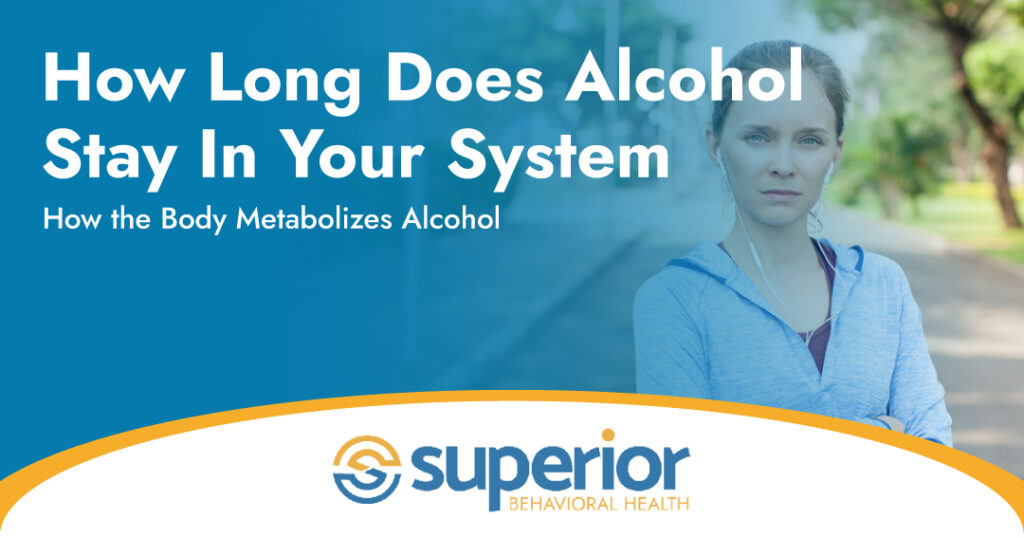Sandra has been using alcohol to numb the traumas that she experienced as a child. She has let this go on for longer than she can remember, and half the time, she doesn’t recognize her reflection because of it. Sandra knows treatment could change her life, but she doesn’t know where to begin.
In 2022, there were 38 alcohol-related fatal crashes in Cuyahoga County, OH. Superior Behavioral Health offers same-day appointments that allow you to get treated on the same day you decide to seek treatment. We love connecting people to treatment with educational articles about substance use. Today, we’re going to answer a popular question amongst our community members: How long does alcohol stay in your system?
How Long Does Alcohol Stay in Your System?
Many people looking for alcohol use disorder treatment might wonder how long alcohol will stay in their system. Other people might wonder how long alcohol stays in their system after an evening of drinking. They might wonder if alcohol is still in their system when driving to work the following day.
A Standard Drink: How Much Is One Drink?
You might have heard that heavy drinking involves drinking 15 or more drinks a week for men and 8 or more for women, but what exactly is a drink equal to? The definition of “one drink” varies depending on what you are drinking. For example, a glass of table wine is 5 fl. oz, while fortified wine is 3-4 fl. oz. Regular beer is 12 fl. oz., while malt liquor is around 8 oz. Other types of alcohol, such as brandy, gin, whiskey, and vodka, are 1.5 fl. oz.
How the Body Metabolizes Alcohol
Alcohol goes where everything else goes first – the stomach. The stomach breaks down alcohol before sending it to the small intestines and the bloodstream. At this point, the liver begins to work as you feel alcohol’s side effects.
Alcohol and the Liver
From here, the liver does most of the work in removing alcohol from your blood. It does this with two enzymes called alcohol dehydrogenase (ADH) and aldehyde dehydrogenase (ALDH). These enzymes break it down into substances that are easy for the body to eliminate. It takes the liver 1 hour to metabolize 1 drink. When there is more than 1 drink in the bloodstream, the liver cannot speed up this process, resulting in the alcohol continuing to circulate, potentially leading to alcohol poisoning, a medical emergency.

Factors for the Rate Alcohol Is Processed
Several factors can impact how your body processes alcohol. These can include your gender. Men can process more alcohol than women can. Also, eating food can make it easier for your liver to metabolize alcohol. Young and older people can also not process alcohol as quickly as someone between those ages. The younger you are, the less your liver can process alcohol. In contrast, older people’s livers have decreased in liver mass, leading to a decline in alcohol elimination.
Alcohol Measured in the Body
There are several reasons someone might test for alcohol. People might test for alcohol at any stage of alcoholism or for instances such as employment or legal evidence. Alcohol testing can occur if someone has symptoms of alcohol poisoning or is driving while intoxicated.
Alcohol Detected in Your Urine
Alcohol can stay in your urine for 12-24 hours. These tests typically are accurate at detecting trace amounts of alcohol.
Alcohol Detected in Your Hair
Alcohol can stay in your hair for 3-6 months. Someone who has been excessively drinking over a period might have a hair test done. Excessive drinking can be one of the signs of alcoholism. These tests do not determine if someone is socially drinking or participated in binge drinking because a hair alcohol test cannot determine the date. Still, they can show alcohol consumption during this period.
Alcohol Detected in Your Saliva
Alcohol can stay in your saliva for 24 hours. This type of testing is uncommon despite it being easy to collect samples.
Alcohol Detected in Breastmilk
Alcohol is in breast milk for 2-3 hours. However, this number is only for 1 drink. The number will increase if a mother drinks more than that in a sitting. For example, if she drinks 3 drinks, it can be detected for 6-8 hours. Often, the highest concentration of alcohol in breast milk occurs between 30-60 minutes, assuming the mother only had one drink. Factors for alcohol in breast milk include the mother’s weight, how quickly she consumed alcohol, and her food consumption.

Seek Alcohol Detox Help at Superior Behavioral Health in Garfield Heights, OH
At Superior Behavioral Health, we help you reclaim your life after alcohol use. Our small, intimate, family- feel allows us to treat you individually since we do not see hundreds of clients. For more information or to start alcohol use treatment, call us at 216-435-1110.
FAQs
How long does it take for alcohol to be fully out?
For most tests, alcohol is no longer detectable after 24 hours. However, hair tests might detect alcohol for up to 6 months.
Is alcohol still in your system after 48 hours?
For most tests, alcohol is no longer in your system after 48 hours. However, hair tests can detect alcohol for up to 6 months.


